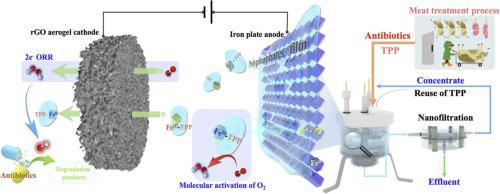Journal of Environmental Chemical Engineering ( IF 7.4 ) Pub Date : 2022-10-25 , DOI: 10.1016/j.jece.2022.108842 Song Cheng , Yutao Liu , Chen Shen , Bicun Jiang , Fuqiang Liu , Aimin Li

|
As a promising advanced oxidation process, electro-Fenton (EF) technology could in-situ generate H2O2 through 2e- oxygen reduction reaction (ORR), and then activate H2O2 into reactive oxygen species to degrade the organic pollutants in wastewater. However, its practical application is limited by the sluggish ORR kinetics and acidic condition (pH < 3), which requires external addition of acids, ferrous salts (FeII) or even H2O2. To improve the efficiency of wastewater treatment, targeted development on EF technology based on specific application scenario is also critical. In this contribution, a flow through EF system was developed to remove the antibiotic pollutants in the meat processing wastewater, where the EF process was significantly enhanced by the reduced graphene oxides (rGO) aerogel cathode and the presence of polyphosphates (PPs). The interconnected 3D porous configuration of rGO aerogel with abundant oxygen functional groups greatly facilitated the mass and electron transfer during the flow-through EF process. Meanwhile, the formation of PPs film on the surface of sacrificial iron anode ensured continuous releasing of FeII under near-neutral condition without rusting, and the generation of FeII-PPs complexes effectively compensated the production of H2O2 via the pathway of molecular oxygen activation. Moreover, 99.9% of phosphorus can be recycled and reused in the flow-through EF system by coupling the nanofiltration technology, enabling efficient removal of antibiotics and utilization of PPs in the wastewater.
中文翻译:

基于 rGO 气凝胶阴极的增强流通电芬顿工艺:四聚磷酸钠的重要作用
作为一种很有前景的高级氧化工艺,电芬顿(EF)技术可以通过2e-氧还原反应(ORR)原位生成H 2 O 2 ,然后将H 2 O 2活化为活性氧,降解有机污染物。废水。然而,它的实际应用受到缓慢的 ORR 动力学和酸性条件(pH < 3)的限制,这需要外部添加酸、亚铁盐(Fe II)甚至 H 2 O 2. 为提高废水处理效率,基于特定应用场景有针对性地开发EF技术也很关键。在这项贡献中,开发了一种流通式 EF 系统以去除肉类加工废水中的抗生素污染物,其中 EF 工艺通过还原氧化石墨烯 (rGO) 气凝胶阴极和多磷酸盐 (PPs) 的存在显着增强。具有丰富氧官能团的 rGO 气凝胶互连的 3D 多孔结构极大地促进了流通 EF 过程中的质量和电子转移。同时,牺牲铁阳极表面形成的 PPs 薄膜保证了在近中性条件下连续释放 Fe II而不生锈,同时生成 Fe II-PPs配合物通过分子氧活化途径有效地补偿了H 2 O 2的产生。此外,通过耦合纳滤技术,99.9% 的磷可以在流通式 EF 系统中回收再利用,从而能够有效去除废水中的抗生素并利用 PPs。































 京公网安备 11010802027423号
京公网安备 11010802027423号